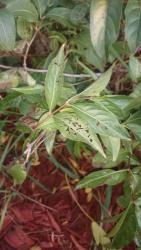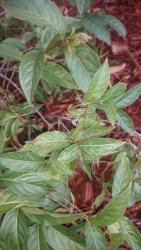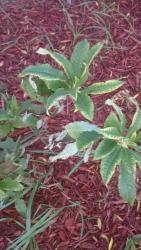Hi ItzSnow. Welcome to NGA!
I agree: insect damage plus tipburn and some necrotic leaves. Fertilizer burn would do that, especially with high-nitrogen fertilizer. I think it doesn't look like sun-scald or sunburn or wind burn ... but someone may know better.
Sometimes with fertilizer, "less is better". One reason is that under-fertilizing at worst just slows a plant down and turns the leaves to a lighter green. The cure is immediate, give it a little more fertilizer. One great gardening cliche about fertilizing indoor plants is: "fertilize weakly, weekly". Outdoors, well, just don;t over-do it.
But over-fertilizing is more like poisoning. One part of that is that fertilizers are salts, and too much fertilizer is just like too much salt. When the ancient Greeks REALLY hated someone, they would sow salt in his fields to kill anything that grew there.
(Technically, the salty water around the roots creates osmotic pressure that tends to suck water OUT of plant roots in order to dilute the salty soil. Hence terms like "fertilizer burn" .
With potted plants, you can flush the salt or fertilizer away by over-watering and making sure the extra water runs out the bottom: "flushing the pot".
You can do that outdoors if you have good drainage. Water more heavily than you would otherwise, as long as the water drains away underground and does NOT leave the ground waterlogged for more than a few minutes. The salts will first be diluted, then actually leached downhill as excess water flows down deeper into the soil, and then flows downslope with the water table.
Roots totally need to get oxygen diffusing through the soil down to them, and oxygen or air diffuse 10,000 times slower through water-logged soil than through well-aerated soil.
"Well-aerated" is the same as "well-drained plus air gaps, crevices and voids between clods or peds". A slope also helps. If your soil is not heavy and clayey, you probably have no drainage problems.
I know that isn't much help deciding how much fertilizer to use after you get that bed straightened out, so try 1/4 of whatever the label says.
Add no fertilizer until the plants recover!
Even then, if winter is approaching, DON'T fertilize at all, because that often stimulates growth. This late in the year, people would call it "late tender growth" and expect the first frost to kill a lot of new, tender leaves. You want your plants to be going to sleep in preparation for "vernalization", (Latin for "winterization"), not revving their engines. Plants hibernate, too.
Once you find a fertilizer rate that seems OK in your yard, you can predict pretty well how much of other kinds of fertilizer you can use without killing things.
Say you have been using 24-16-18. Say that 1/2 cup per bed seems OK.
Now say you buy 50 pounds of much cheaper 10-10-10 fertilizer.
Usually the most toxic part will be the nitrogen compounds.
Find the fraction or factor you get from the ration of "N numbers".
In this case, 24 / 10 is 2.4.
You can probably use 2.4 times as much 10-10-10 as you used 24-16-18. Without KILLING plants.
But now ask "What is the least amount I can use?" or "What is the best amount I can use?"
Surprisingly, that would probably be "zero".
If you can get enough organic matter into your soil, and it is well-aerated, soil microbes will dissolve the organic matter and release its nutrients. The humic acids they release while doing that dissolve the surface layer of mineral grains to release more minerals gradually. The organic matter (e.g. compost) also improves "tilth", that is, soil structure which improves BOTH aeration AND water retention, which usually trade off AGAINST each other.
The garden cliche for that is: "If you feed the soil, the soil will feed your plants". Without root burn or leaf burn. Cheaper than synthetic compounds. And it disposes of organic "waste", as compost, sometimes called "black gold".
The nice thing is that higher plant roots and soil microbes have co-evolved over some 400 million years to "eat" in exactly that way. Sometimes chemically added nutrients, especially TOO MUCH fertilizer, will "turn off" desirable soil microbes and root fungi (mycorrhizae, but I have to look that up every time!) Some of those desirable microbes provably protect the roots from other microbes, plant pathogens. They more they study those, the more complicated and sophisticated that "soil community" is found to be.
Anyway, the short answer to "how much synthetic fertilizer is best?" really is "Zero, IF your soil has enough compost added every year". The living soil community will turn the compost gradually into perfect plant food.
I only add chemical fertilizer while bringing "raw, unimproved dirt" up to fertility, or to keep growing very heavy feeders in the same beds for years (crops, not flowers). Even then, if i could make or buy enough compost, I would use a 3" thick layer of compost twice per year rather than any chemical fertilizer.
That nice mulch will gradually turn into compost where it touches the soil surface. When you are ready to add more mulch, you might first spread several inches of compost (from bags, or from your own heap). Turning it under and mixing with soil gives faster results by feeding soil microbes instantly, but "no till" or "low till" probably is best for soil structure, at least after you have done the first few years of soil improvement.
Chemical fertilizers should go along with soil tests, because it is SO easy to over-fertilize, or fertilize with the wrong things. If you soil already had plenty of N and almost enough K, all it needed was P. If you then add too much N,. the plants will tell you about it - by dieing.
Plants are very good communicators, that way. Every gardener learns by killing plants. One lady told me that if I hadn't killed a hundred plants YET, I wasn't trying hard enough. She liked to push her climate zone and try plants that were challenges. That's how we all learn.
Sorry this was so long! Good luck!
P.S. A few insect holes might be better for the plant than enough insecticide to kill the bugs. No matter how many you kill, there are always thousands more. Also, if the plants are new, give them time to adapt before you bring out the organophosphate nerve gasses.
Plants have some mechanisms for deterring insects, and any population explosion of one bug eventually attracts insect-predators that then have a population explosion and reduce the numbers of your plant-eaters.
I read a study where agronomists (or is it horticulturists?) studied a big field of some plants. Then they introduced insect pests to one end of the field, containing the insects somehow. They wnated to study the isnect-infested plants aginst the "normal" plants that had not been attacked.
They expected to see the infested plants activate their defenses, and the uninfected plants NOT activate their defenses.
I swear to you that plants seem to know what we're thinking and DELIGHT in tricking us.
The scientists found that the whole field of plants turned on their defenses as soon as any of them were heavily attacked!
I'm sure the scientists scratched their heads until they were bald.
Eventually someone figured out that the plants were COMMUNICATING through their ROOTS! They sent a variety of chemicals out of root hairs, and adjacent root hairs picked them up, reacted, and sen6 out more of the same. The message raced from plant to plant and caused the entire field to protect itself as soon as one little patch detected the need.
"Warning, Warning, Will Radish-son! Incoming aphids and cabbage worms!!!"
They could prevent the communication by digging a moat, or inserting plastic barriers into the soil!
Plants aren't dummies, even if they have no brains!



